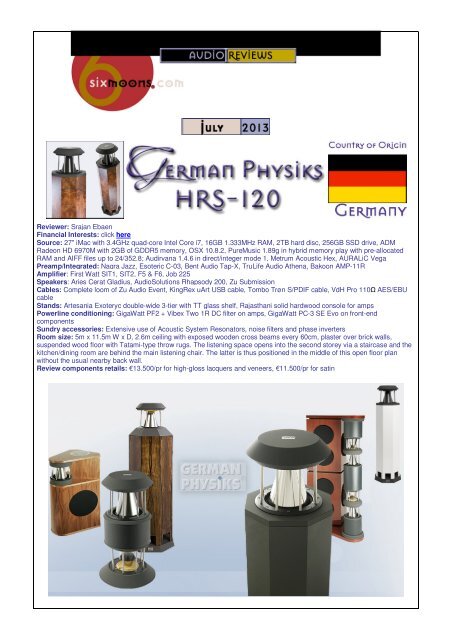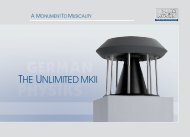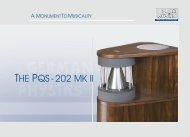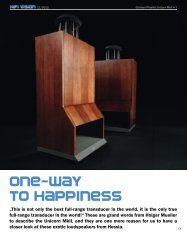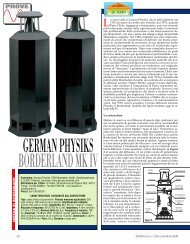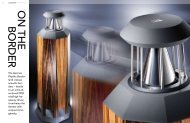Download 6Moons test report. July 2013 (PDF). - German Physiks
Download 6Moons test report. July 2013 (PDF). - German Physiks
Download 6Moons test report. July 2013 (PDF). - German Physiks
You also want an ePaper? Increase the reach of your titles
YUMPU automatically turns print PDFs into web optimized ePapers that Google loves.
Reviewer: Srajan Ebaen<br />
Financial Interests: click here<br />
Source: 27" iMac with 3.4GHz quad-core Intel Core i7, 16GB 1.333MHz RAM, 2TB hard disc, 256GB SSD drive, ADM<br />
Radeon HD 6970M with 2GB of GDDR5 memory, OSX 10.8.2, PureMusic 1.89g in hybrid memory play with pre-allocated<br />
RAM and AIFF files up to 24/352.8; Audirvana 1.4.6 in direct/integer mode 1, Metrum Acoustic Hex, AURALiC Vega<br />
Preamp/Integrated: Nagra Jazz, Esoteric C-03, Bent Audio Tap-X, TruLife Audio Athena, Bakoon AMP-11R<br />
Amplifier: First Watt SIT1, SIT2, F5 & F6, Job 225<br />
Speakers: Aries Cerat Gladius, AudioSolutions Rhapsody 200, Zu Submission<br />
Cables: Complete loom of Zu Audio Event, KingRex uArt USB cable, Tombo Trøn S/PDIF cable, VdH Pro 110Ω AES/EBU<br />
cable<br />
Stands: Artesania Exoteryc double-wide 3-tier with TT glass shelf, Rajasthani solid hardwood console for amps<br />
Powerline conditioning: GigaWatt PF2 + Vibex Two 1R DC filter on amps, GigaWatt PC-3 SE Evo on front-end<br />
components<br />
Sundry accessories: Extensive use of Acoustic System Resonators, noise filters and phase inverters<br />
Room size: 5m x 11.5m W x D, 2.6m ceiling with exposed wooden cross beams every 60cm, plaster over brick walls,<br />
suspended wood floor with Tatami-type throw rugs. The listening space opens into the second storey via a staircase and the<br />
kitchen/dining room are behind the main listening chair. The latter is thus positioned in the middle of this open floor plan<br />
without the usual nearby back wall.<br />
Review components retails: €13.500/pr for high-gloss lacquers and veneers, €11.500/pr for satin
Gender bender. What do various Linæums including Audio Consulting's<br />
Rubanoide, the Manger, the Goebel, Shelley Katz's Podium Sound panel and the<br />
Ohm Walsh of yore, the NXT, Naim BMR and <strong>German</strong> <strong>Physiks</strong> drivers have in<br />
common? Pistonic transducers shun surface oscillations or at least claim to. These<br />
bending-wave drivers exploit 'em and live to tell the tale. From reading their small<br />
print, it appears that in fact they all transition from one mode of operation to various<br />
others. Over a variably broad band this includes pistonic. Yet what in a purely<br />
pistonic device would be considered a break-up mode—i.e. distortion and<br />
thusbaaad—becomes legitimate desirable behavior in a bending-wave unit. Without<br />
getting into the small print of math and Physics which exceed my comprehension,<br />
it's fair to posit that creating a bender with linear performance over its chosen<br />
passband must be a rather complex matter. This wonky club includes flat types in<br />
bi- and monopolar flavors; curved types of either persuasion; and today's <strong>German</strong><br />
<strong>Physiks</strong> whose hoary ancestor was one Yankee named Ohm Walsh. Dubbed DDD<br />
or Dick's Dipole Driver for its (re)inventor, it's a funnel-shaped omnipolar<br />
contraption. This steeply elongated cone has a spider/motor on one end and<br />
terminates in a rubber suspension at the other. Not just capable to push/pull like a<br />
regular dynamic unit, the same applied force also causes the diaphragm to flex and<br />
ripple. Bending waves. Though simplistic it illustrates the mixed general principle.<br />
From it follows that this driver cannot be built into an enclosure as<br />
that would obscure its radiating surface. If it stuck out horizontally,<br />
you'd have zero direct sound, just pure reflections from ceiling<br />
and floor. The only places it thus can go are the enclosure top; or<br />
as a vertical armature attachment with up- and even downfacing<br />
units joined in the middle, perhaps even multi-paralleled for a linesource<br />
array whilst the main tower then could house equivalently<br />
stacked woofers in various configs.<br />
Because their DDD is a wideband transducer, all <strong>German</strong> <strong>Physiks</strong><br />
models thus are two-ways and most of them sport a downfiring<br />
woofer topped by a triple D. Firing out a box on both ends also<br />
neatly accomplishes matched omni dispersion.<br />
This now segues us into today's review model. Its simpler<br />
cheaper Limited version runs in a rectangular box. The nattier<br />
dressed HRS-120 goes octagonal and fancy veneers or lacquers.<br />
The driver itself comes in go fast and go faster versions with a<br />
0.025mm thick Titanium or 0.15mm Carbon fiber foil.<br />
If for the HRS-120 we look at spec skewing between driver<br />
versions, we see that impedance remains unaffected (4 ohms for<br />
both) but that carbonated response hits 24.000Hz rather than<br />
21.500; that power handling goes up by just a whisker and<br />
efficiency by 0.4dB*.<br />
* "Sonically the Titanium DDD has a little better low-level detail<br />
but the Carbon has a more extended response at both ends and<br />
better transient response. You can drive it with big transients and<br />
it is very, very hard to break. Titanium is more fragile and there is<br />
a possibility to break the diaphragm if you go crazy. For normal<br />
sensible use this is no issue. Also if you touch the Titanium<br />
diaphragm it will dent. This is unsightly even though you can inflict<br />
quite a lot of damage to it before there's any audible effect.<br />
Our crossovers curtail HF response since, the Carbon otherwise<br />
would go to ~30kHz, but it does become a little ragged up there."
The actual review pair at HighEnd Munich <strong>2013</strong><br />
The high-pass filter remains at 240Hz for either driver with a 2nd electronic and ultra-steep 6th-order acoustic function to<br />
add to a very rapid exit at 48dB/octave. The woofer sports mirrored 2nd-order electronic/acoustic slopes for a<br />
24dB/octave filter function. With the Titanium unit the accompanying bass unit is an 8-incher to net an F3 of 31Hz. For the<br />
Carbon this grows to 10 inches and 29Hz. Overall dimensions are a 32 x 32cm footprint (12.6") and 1.14m height (45") for<br />
both. There's also an HF adjustment of -2dB, 0, +2 & +4dB centered on 8kHz with a notch filter and selected with a<br />
jumper above the speaker terminals. Efficiency is ~87dB and thus slightly less than the DDD would do solo.<br />
Fender bender or gender mender? The most unimaginatively christened HRS-120 could seem like a Napoleonic sort:<br />
short of profile, thirsty for power. But lest we think temperamental—the Bonaparte reflex would— 360° horizontal<br />
dispersion from top to bottom promises good in-room bass behavior, non-critical placement in general plus democratic<br />
rather than dictatorial imaging regardless of seat. If that conjures up happy-happy notions of a small equally omni equally<br />
Teutonic Duevel Planet for chump change, check your wallet. You'll need at least €11.500 depending on finish. Hi-tech<br />
from a smaller <strong>German</strong> company who invested heavily into R&D doesn't come cheap. There's the need for amortization<br />
which presumably clashes with lower sales volumes, a shrinking market and globally stalled economics. Hence<br />
acquisition of even this small <strong>German</strong> <strong>Physiks</strong> model goes wildly beyond just paying for a fender bender. Whilst on<br />
rhymie pairs, lack of grill (like Marchisotto's old Alon models, this would have meant an unsightly inverted trash bin<br />
solution) may not make for a gender mender with approval from she who rules the house. But there's always the<br />
audiophile dungeon. Of course her hated must-sit-here-and-don't-move-yer-head thing has packed it too. With a proper<br />
demo to demonstrate the benefits of omni radiation (just don't play her your moldy audiophile demo discs), the top's<br />
techno look might become a proper décor blender. And now I've run out of silly enders. Time to get serious about sound.
Packed in heavy-grade double-boxed cardboard lined with form-fitting foam huggers and additionally protected in a<br />
cloth sack with flexible foam rings around top and bottom MDF caps, carbon DDD shielded from dust behind cling wrap,<br />
reversible spikes with point and ball ends in a separate folder with a <strong>test</strong> CD and owner's manual, the HRS-120 proved to<br />
be easy to carry and set up. Because I'd requested shipping without <strong>German</strong> <strong>Physiks</strong>' de rigueur pallet—I don't own a<br />
pallet strapper and storage is limited—a likely drop of one box had loosened the top assembly of one speaker. It fell off<br />
whilst I walked the speaker up my stairs. Apparently a first for the company, perfectionist Teutonic pride had taken a hit<br />
but the only physical damage was to the painted MDF cap. This screws directly into the DDD's top-facing magnet with<br />
one fat central bolt. The very same day the Frankfurt-based factory dispatched a replacement cap and some Ponal wood<br />
glue to have me reseal the head/enclosure seam and prevent possible leakage of the DDD's backwave which loads into<br />
its own sealed section of the octagonal pipe. Problem solved. The firm probably won't ship without a pallet ever again.<br />
1: a conventional spider suspends the funnel's apex | 2: an inverted rubber surround terminates it on the bottom | 3: facing<br />
the listening space | 4: the DDD assembly topped by the magnet with MDF cap removed.<br />
As the photos show, the DDD is a bit like a megaphone. It stands on its bigger open end with the magnet blowing in. But<br />
sound doesn't travel alongside its expanding inner wall as it would in a real megaphone. Instead the wall itself vibrates to<br />
generate sound inside and out. What's usually the rear wave firing straight back into its enclosure here first is an inner<br />
wave. For the vast majority of the driver this inner wave reflects off its own membrane multiple times before it migrates<br />
into the heavily stuffed upper portion of the octagonal enclosure proper. This reflective action of the inner wave is bound<br />
to interact with the outer wave unless the oscillating funnel sat atop an absorptive inner pointy hat like a Zu Griewe<br />
cartridge.
Setting the HRS-120 up where all other speakers tend to go, the first sonic thing to strike this listener imprinted and<br />
conditioned by conventional monopole sound was how differently the omnipolar HRS-120 energized the room. Thinking<br />
about it beforehand, I knew perfectly well that it would. Yet the actual experience of just how loudness would register<br />
differently was still novel. That's because here the sound was just as loud to the outsides of the stereo triangle—behind<br />
and around the boxes—as it was between and in front of the speakers. This telegraphed even with the preamp set for atear<br />
loudness at my normal level. The sound pressure inside the space was higher. As such it also was far more even. So<br />
what? All that matters is what arrives at your ears, let the ants crawling up the front and side walls have their own party?<br />
Arguably so. Even so this denser room fill translated as greater fullness with my ears where they've always been, about<br />
four meters from the speakers and as such not in those room areas, which now got far more direct sound than before.<br />
We'll return to this.<br />
As a consequence in this first position shown above, the HRS-120 seemed very hooded, its fine uppermost freqs<br />
overpowered by and drowned out in all these compound midband reflections. Setting the tweeter contour to +4dB to rise<br />
at 8.000Hz counteracted it only marginally. This really wasn't about tonal balance in the signal, but acoustic room<br />
loading outside the signal. Tone control tweaks don't really operate there.
Setup adds significant variables and more profound than with forward radiators. That's because close wall proximity<br />
(front, sides) reduces the time gap between direct and reflected sound. Our brain sums those two actions into a singular<br />
albeit blurred event. Only when wall distance begins to exceed ~1.3m does the brain separate direct and reflected sound<br />
into two discrete events of original sound + echo/reverb. This separation strips off the blur from the direct primary sound<br />
and turns it into a secondary effect. The recorded signal gets precedence. Let's take a lesson from <strong>German</strong> <strong>Physiks</strong>' own<br />
Munich <strong>2013</strong> setup to see how they dealt with my very review pair.<br />
Not only were their HRS-120 well removed from all vertical boundaries—particularly the front-wall distance should be<br />
utterly impractical for most domestic situations, but even the side wall distance was quite extreme—the long walls were<br />
strategically covered by absorptive panels. That's another massive no-no for most homes. Relative to being realistic on<br />
what to expect in a standard living room, <strong>German</strong> <strong>Physiks</strong>' presentation thus was most deceptive and cheated very<br />
badly. One could rightly question why even engineer an omni speaker if one proposed to kill off half its radiation for best<br />
results (in truth less than half if we account for how their side-wall absorbers were less and less effective at lower<br />
frequencies). To lighten up my own midrange/upper bass soup meant moving the HRS-120 inward to create sufficient<br />
side-wall distance. This increased subjective clarity but didn't yet add more airiness. The sound still didn't have the<br />
desired energetic jump factor or speed. I asked Ivette to sit down and opine. She called the speakers perfectly<br />
inoffensive (translated: boring) and essentially wanted to know just how soon we could get back to our own.
As a reviewer I couldn't capitulate yet. The next order of business was increasing the front-wall distance. Having<br />
parked the HRS-120 on the ball ends of their spikes and those into Track Audio's aluminum shoes with removed felt<br />
pads to slide easily on my sisal rugs—those double as indestructible scratching post for Blondie the cat—this was<br />
child's play. Once the speakers cleared the front wall by two meters i.e. an additional 80cm from before, I had magically<br />
regained the type of depth layering and see-into finesse and lightness I consider normal for this room and what its<br />
layout and furniture will accommodate [see below].
Final position - 1.2m from the side walls, 2m from the front wall.<br />
There's thus absolute necessity to give the HRS-120 sufficient room to bloom. This very basic adjustment transformed<br />
the speaker's initially very luke-warm reception as a sluggish polite warmish hazy old-timey performer into a super<br />
spacious fleet-footed, far more resolved exciting modern speaker.<br />
The live/playback duality. To appreciate the inherent issue raised by the HRS-120, we need to pause a moment. To<br />
put it at its most elemental, live sound = eyes + ears and in that sequence. Even for audiophiles eyesight remains their<br />
dominant sense. With live sound we don't need ultra-precise aural localization markers. We still get perfect<br />
image/distance lock. Our eyes fill in those data the very moment the musicians sit down. We know exactly where<br />
everyone is relative to us, whether they make a sound or not. Each time the bass player plucks his strings we see it. This<br />
fills in whatever aural component might actually be masked. At home there's zero original eye information. We literally<br />
navigate blind. Now the higher beaming frequencies become the localization beacons of our virtual imaging. And therein<br />
lies the crux. Whilst the more diffusive somewhat amorphous <strong>German</strong> <strong>Physiks</strong>-type presentation—a wall of sound and as<br />
such somewhat homogenous—is actually far closer to live sound per se, this presumed advantage doesn't fully account<br />
for playback's absence of visual cues. Meanwhile the very directional radiation pattern of conventional tweeters plays to<br />
it. As a purely aural effect it's unnatural. In the absence of visual data it's the better approximation however.
Still looking for the optimal setup, this inter-speaker spacing here had narrowed over the first attempt but the<br />
front-wall distance was still insufficient.<br />
This is at the heart of widespread audiophile obsession with soundstaging, imaging, performer outlines, layering etc.<br />
First and foremost these are visual qualities translated into the aural domain. By themselves they're completely artificial<br />
and unrelated to live sound. But because playback itself is unnatural—no visual data, just two sound sources faking up<br />
as many sources as there are performers—one artifice overlaid on another makes for a more complete experience. In<br />
its own way it appeals a bit to our visual perception, which during a live performance is automatically cross-coupled to<br />
our ears and constantly processed by our brain. By design the HRS-120 homogenizes the intensity of localization cues<br />
because its tweeter is an omni. Whether you approve or not shall very much depend on whether you subscribe to the<br />
stereophonic ideal; or to live sound minus its natural visual dimension (which would be like a blind person hears). For<br />
those in the first group, could the HRS-120 be a natural-born super tweeter candidate to add purely directional treble<br />
cues over and above its native 360° radiation pattern? With ENIGMAcoustics' Sopranino inbound for its own review, I'd<br />
find out.<br />
Have you ever turned to a friend during a performance and gushed over just how airy it all sounded? If you think<br />
closely, live sound really is far more midrange-y and bassy than the typical hifi sound. Qualities like performer halos,<br />
endless decays, spiderwebby venue reflections and such mostly don't occur in real life because our ear isn't a<br />
microphone pickup clipped to the bridge of a guitar. The practice of multi-tracked close-mic'd recordings played back<br />
over just front-firing speakers has conditioned us to call a quite unnatural energy balance right. If it's airy you crave, you<br />
have your work cut out with the <strong>German</strong> <strong>Physiks</strong>.
With Apple/SOtM/Metrum/Nagra front end and SIT1 monos in the final position.<br />
Here we must distinguish between just sound where The Abso!ute Sound abstract is the gold standard; and subjective<br />
experience. Do we expect playback to be an acoustic clone of the live event, sound for sound identical? Do we expect<br />
a similar experience? The latter is very different. Since playback shrinks the multi-sensory live experience down to just<br />
our ears, even if the sound were a carbon copy the total experience could never be. Different venue, different seat, solo<br />
vs. crowd listening. So listeners hoping to be emotionally stimulated as though they responded to real musicians in<br />
their room welcome alterations to 'just the sound' if those changes deepen their emotional response. If it's a<br />
suspension of disbelief we crave, whatever promotes it isn't merely allowable. It's key. If we mean to change our<br />
experience's flavor to become more visually or mentally stimulating—or in various ways other than the live experience<br />
to exploit the freedom that as an artificial construct we can make it anything we damn well please—whatever serves<br />
our purpose is fair game. Back to airy diaphanous treble energetics, if those trigger points are a must, the HRS-120's<br />
radiation pattern and subsequent weighting of the at-ear response first and foremost require space.<br />
After my setup had arrived, the obligatory march through my amp inventory progressed from cost-effective but quality<br />
Wyred4Sound high-power D-class mAMP monos to class A/B Goldmund/Job 225 to class A FirstWatt SIT1. It called<br />
the first too warm, the last slightly too soft and mellow and the DC-coupled wide bandwidth jobbie in the middle just<br />
right. Whilst Nelson's monos did the even more spectacular ambient recovery and depth mining, the higher-power<br />
Swiss amp with its stiffer damping factor was the crisper around the edges, the most controlled/articulated in the bass<br />
and in this context also the most lit up overall. This combo of traits best suited the <strong>German</strong> <strong>Physiks</strong>.
Another very happy observation was the perfectly matched sealed bass loading and downfire orientation of the <strong>German</strong><br />
woofers with my infrasonic Submission sub from Zu. This made for a terrifically seamless handover in the very first<br />
octave (and the nearly matching white lacquer didn't hurt either to complete a visual match). My mental psych eval had<br />
morphed from disappointed, to promising, to thoroughly thrilled, over just two days. This exam would conclude with top<br />
marks.<br />
Obvious virtues were gargantuan where-are-the-boxes soundstaging of stupendous depth; chewy highly incarnate<br />
sound density, very different from ghostly electrostatic leaniency; non-resonant bass; complete freedom from the headin-a-vise<br />
syndrome of highly directive speakers; and from-a-cloth continuousness one gets from a Rethm widebander<br />
albeit without any remaining forwardness or blister but superior upper treble. The general presentation reminded me of<br />
a Gallo/Zu hybrid. From Gallo I had a vertically lifted deep-space Ref 3.5 reading without its obvious panel-speaker<br />
speed. From Zu I had Druid V tone density and warmth without its upper midrange/lower treble opacity. Of great<br />
cosmetic benefit was the compact form factor with very small footprint, which stood in stark contrast to the cinerama<br />
panorama of sound. A cosmetic detractor was the need to be far into the room. Here the very easy sliding weight and<br />
utter disregard for toe-in meant that the speakers could be easily pulled out for proper listening, then parked close in<br />
the corners for social living room use.
Real versus canned. Play it again. Lovers of vinyl and tubes often<br />
agree that compared to good live sound—live sound can be<br />
terrible as well with the wrong venue, bad seat or poor sound<br />
reinforcement—digital and transistors tend to sound washed out.<br />
At their core they might seem strangely insubstantial despite their<br />
deep gloss of intense detail. If that's your sentiment, the HRS-<br />
120's far higher percentage of reflective sound aka acoustic reverb<br />
gives it certain vinyl & tube-type benefits without their actual<br />
appearance. No glowing bottle or slab of vinyl required. That's<br />
perhaps the DDD's grea<strong>test</strong> asset. Like all good medicine<br />
however, the wrong dose turns poison. So don't short-circuit the<br />
time-arrival difference between direct and reflected sound with<br />
insufficient distance from boundaries. When there's fusion, things<br />
go murky, bloated and blurry in a hurry. Grea<strong>test</strong> asset turns into<br />
lead-weight liability. Hand in glove with this goes that even at its<br />
best, no 'omni' will ever focus as razor-sharp or cut out performer<br />
silhouettes like direct radiators manage it with their progressively<br />
narrowing treble units.<br />
Unlike a Duevel which routes a conventional dome tweeter through a dispersion<br />
lens; or a Morrison that scatters it off a hard dome reflector; the DDD's sheer<br />
radiating surface for its HF is far larger to reflect as a better in-room power<br />
response. Set up properly its focus is less vague than other omni variants though<br />
not as specific as direct radiators. That's the payment one renders to obtain its<br />
natural built-in tone, which isn't a function of harmonic distortion weighting, but inroom<br />
energy. Unlike most widebanders with which it otherwise shares expanded<br />
bandwidth - AER, Fostex, Lowther, Voxativ - the DDD has far higher power<br />
handling. As Munich showed, the smallish HRS-120 will happily energize a much<br />
bigger space than most home dwellers have at their hifi disposal. The DDD also has<br />
higher mass and as such far lower efficiency than traditional paper-cone<br />
widebanders.<br />
With Norma IPA-140 in direct mode preceded by the Nagra Jazz.
On natural tone multi-polar speakers do things differently and arguably<br />
far better than the dominant (barbarian?) hordes of conventional<br />
radiators. From a Shahinian Obelisk to FJ's Ohm of yore, to Dick<br />
Olsher's bygone mini cube with upfiring mid/woofer and front-firing<br />
tweeter, to the already mentioned Duevels and Morrisons and my<br />
Boenicke B10 at right and even the Bose 901, there have been<br />
numerous attempts to energize or 'activate' our playback venues more<br />
evenly as happens during a performance. Planars with out-of-phase<br />
front/back radiation suffer lateral figure-8 phase cancellation. They aren't<br />
omnis to the same degree (and a more appropriate term in the first place<br />
would be polyradials, since true omnis would have to include floor and<br />
ceiling radiation like a pulsating sphere suspended in free space, which<br />
no speaker does). The DDD radiates in-phase like a lighthouse would<br />
disperse light, without its rotating flare. It radiates directly without first<br />
reflecting off its own structure like speakers with dispersion lenses. The<br />
net result is tonal fullness, linked to in-room energy density, linked to<br />
perceived loudness. You can play the HRS-120 at low volume without<br />
diluting this fullness, which arises from more complete room fill.<br />
Meanwhile high volumes scale up more intensely. They load up the<br />
entire space with sound pressure increases in (nearly) all directions.<br />
This would seem to be a more effective less lossy conversion of<br />
amplifier power into loudness, going beyond the basic voltage efficiency<br />
equation where 'x' input voltage nets 'y' decibels at 1 meter on axis.<br />
On that count I was simply tickled that for my civilized<br />
purposes the 10wpc SIT1 didn't run out of steam,<br />
though they did seem to run extra hot. Devotees of big<br />
symphonica or music with punishing bass transients, will<br />
most certainly want more headroom and grunt. I simply<br />
think that stuffing an 80-piece orchestra into a space<br />
barely sufficient to properly hold a string quintet is a<br />
ludicrous proposition. It's as far removed from 'realistic'<br />
or 'believable' as one could get. I thus do precious little<br />
of such extreme stuffing. Back to amplifier matching, I<br />
also tried Norma Audio's 2MHz IPA 140 integrated. This<br />
again was a bit too soft, even in direct mode with my<br />
Nagra, which quickens its performance. Resolution<br />
Audio's Cantata C50 mated slightly better, but not nearly<br />
as well as the Job 225. Whilst the Norma had the<br />
highest bandwidth for presumably fas<strong>test</strong> rise<br />
times and the most raw power, those factors weren't<br />
decisive. What about the Job inked the deal I don't<br />
know. I can't make an educated guess about ideal specs<br />
an amplifier shopper for this speaker should cross off.<br />
What I can say is that this $1.495 amp very nicely offset<br />
some of the HRS-120's steep €11.500 satin-finish<br />
sticker.
All speakers transition from half-space to full-space radiation at lower frequencies. The HRS-120 is full-space all the way<br />
and thus probably 6dB more efficient than its actual rating. Why should we limit ourselves to predominantly on-axis<br />
energy when the air surrounding us so completely can potentially deliver sound from a lot more directions? As covered<br />
this cuts two ways. From this follows that just because the previously reviewed Manger also was a bending-wave driver,<br />
it didn't sound anything alike. The dominant expression isn't the drivers' overlapping operational principle. It's how they<br />
load the room. Now we're at the heart of the matter again. The HRS-120 loads our space like actual performers would.<br />
Isn't that perfect? Not if you mean to hear the recorded venue! By activating our space, that room becomes more<br />
dominant than ever to overlay itself on everything. Whilst this works quite well with purist recordings and for symphonic<br />
and live performances recorded in reverberant space, close-mic'd endlessly parallel-tracked productions as the vast<br />
majority of recordings are give up some of their core signatures of sharp separation.<br />
What they gain even if sizzly of aspect is more natural tone. To put it cavalier but perhaps most succinctly, the<br />
<strong>German</strong> <strong>Physiks</strong> HRS-120 gives someone a taste of a good analog tube experience without getting their hands dirty<br />
by sticking with digital and transistors. It's a very pleasing acoustic coloration added to the recorded signal. Even so,<br />
it's operationally far closer to a live performance than highly directional speakers. Those attempt* to play as though<br />
they were in an anechoic chamber (obviously with no success in the lower registers but achievable in the high<br />
frequencies in a normal room with absorptive/diffusive furnishings).<br />
* If you think about it, <strong>German</strong> <strong>Physiks</strong>' Munich show demo had exactly that effect with their sidewall<br />
absorbers/diffusers. Particularly effective at high frequencies, they cut back on the omni aspects of the DDD's treble to<br />
there perform more like a forward radiator. HF reflections off their faraway front wall's floor-to-ceiling glass were too<br />
far delayed in time and too weak in amplitude to matter. The upshot? Better soundstage specificity to better suit<br />
people's expectations based on conventional speakers. That the real intent was to combat "terrible flutter echo" didn't<br />
matter.
My original setup as a reminder. Those boundary distances were patently insufficient.<br />
To recapitulate, when set up properly there's rich and meaty, but not fat or sloppy tone, which doesn't change in<br />
volume or fullness anywhere between top and bottom. There's extravagant soundstaging. There's very little<br />
conventional box talk. There's no port resonance with its phase/timing issues. There's unusual dynamic scaling in the<br />
macro sense. Transients are well defined and clean, but not razor-edge honed as they can be with acoustically drier<br />
speakers. Such mellower leading-edge behavior coupled with redolent tone isn't fuzzy soft like a heavily loaded 2ndorder<br />
THD colored sound, but clearly non-hard and non-incisive regardless. Rethm's Jacob George should find it<br />
insufficiently illuminated, aerated and quick. On tonal bloom and transient texture, it operates in a farfield rather than<br />
nearfield milieu. Extreme separation—what I call lucid mode—isn't part of this package. If one wished to tone down this<br />
character and narrow its difference with 99% of all other speakers, one would select a lit-up incisive very fast amp like a<br />
Bakoon or Job 225. You might say that this defeats the purpose. Why not celebrate this difference to its very max with<br />
a mellow darker amp? For myself I was perhaps too deeply engrained by the conventional stereo ideal to insist that<br />
moderation was key. I know what I like and what I think sounds right. There's not much leeway. But getting into this<br />
inner circle with diametrically opposing means is great fun and retains sufficient personality to not require going to<br />
caricature extremes. And the Job 225 driving the HRS-120 worked right within my inner circle whilst doing so from a<br />
new perspective. Those are the basics, which due to unusual operation required more space than usual.
Fringe benefit. If you use Spotify+ or similar streaming services to discover<br />
new music, you'll appreciate that 320kbps feeds are tonally crippled. Not so<br />
over the HRS-120. Using Spotify's new discover feature—it mines their data<br />
base to suggest things based on your recent activities—I was told that<br />
having listened to Taksim Trio 2, I might like Erkan Oğur's Yazi Tura<br />
soundtrack. Loving this Turkish guitarist's Bir Ömürlük Misafir album, but<br />
being unaware of this one, I hit play. I guarantee your shock at being told it<br />
was a lowly MP3. Dimensionality and textural wetness didn't let on at all. If<br />
you're too snobby to even know about Spotify, you could care less. Fine.<br />
Otherwise you'll agree. It's far from marginal. So be pragmatic. If this<br />
acoustic room response has you listen longer and to far more varied and<br />
outright forbidden fruit, how could it possibly be a bad thing?<br />
Flipside. AsiaBeat's Spirit of the People is a percussion-intense Malaysian<br />
music project with densely woven beat patterns called bols, echoes of<br />
Balinese Gamelan, happy synth melodies and a fun playful and often cyclical<br />
overall vibe like a multi-armed multi-legged Indian deity dancing. Since nothing<br />
can escape the <strong>German</strong> <strong>Physiks</strong> acoustic makeover, tight drum rolls and other<br />
rapidly alternating staccato sounds become texturally less distinctive as though<br />
someone smudged over a not altogether dry signature in ink. That's why you<br />
wouldn't play top-level flamenco in a heavily reverberant church. Unless you<br />
didn't mind streaky arpeggios and blurry footwork. That's a bit overwritten and<br />
also a function of how far you separate direct sound from its reflections with<br />
setup distances. Still it's the flipside of richer wetter decay-enhanced tone.<br />
Think watercolors, not pixel count.<br />
As typical for hifi it's about picking your compromises. The narrow-dispersion<br />
front-radiating speaker is a deliberately dry mastering studio. An engineer<br />
gets paid to hear deep into a recording for flaws. The polyradial speaker is a<br />
deliberately wet performance venue. It beautifies tone, maintains tonal<br />
consistency regardless of seat or frequency and minimizes a collapsed<br />
stereo perspective when leaving the center. For the non-audiophile pleasure<br />
listener who enjoys company, the preference should be crystal. For<br />
someone graduated from audiophile listening who wants to trade seats with<br />
the mastering engineer, this true omni might not be dry enough. It's really a<br />
soul search. What do we expect of our hifi?<br />
As a former Pilates instructor I still do Joe's abdominal floor work on a narrow camping mat in front of my hifi. In this<br />
unusual position—doing supine audio worship against piss-poor downward radiation, extreme off-axis response and a<br />
complete lack of focus as a result—I was shocked to for once hear a properly developed soundstage without any hole<br />
in the middle. That's on the floor between the speakers, their up-angled drivers one meter above my ears. It's<br />
admittedly a strange bonus but still. And because I do my routine late in the evening, playback volumes must be very<br />
low. Here too the HRS-120's very effective room gain paid out big. I heard more with less. Audiophile discourse<br />
routinely skips over whisper levels. It <strong>report</strong>s on extreme SPL which no civilized or sane user selects. The more<br />
complete and full a speaker sounds at low volumes, the more you will actually use your hifi. Here the <strong>German</strong> <strong>Physiks</strong><br />
beat up on the hi-eff crowd. Their 96dB+ on-axis voltage sensitivity is not as practical as the HRS-120's ~93dB fullspace<br />
loading. Given my preamp's volume control position that latter figure seems about right to explain why my<br />
10wpc monos didn't shrivel up.
The HRS-120 acted as though it had very<br />
clean impulse response. Digging deeper<br />
into their website I found this on their<br />
Borderland model, a bigger version of the<br />
HRS-120. It's a graph from a <strong>German</strong><br />
review. Whilst inverted it's very clean and<br />
settles rapidly. This gave me the idea to<br />
invert polarity on the amplifier. Gallo's<br />
Strada 2 is very sensitive to proper as<br />
opposed to absolute polarity from the<br />
amp. This type of time-accurate speaker<br />
can sound noticeably better one way than<br />
the other. What will be the better polarity<br />
isn't predictable. It must be tried and isn't<br />
the same as inverting source polarity<br />
Using "No Ha Podío Ser" from Gerardo Núñez' spectacular Travesía<br />
Flamenco guitar album as the decider, 'wrong' polarity was clearly right. It was<br />
an easy tell too. This seemed to support my suspicion. Like its bigger brother<br />
the HRS-120 must have a very clean impulse response. Otherwise the wire<br />
reversal wouldn't have been as obvious. That's the takeaway. This speaker is<br />
accurate enough in the time domain to be sensitive about such matters. My<br />
admiration for what on sight appeared to be a very simple design that<br />
shouldn't cost this much grew even more. When executed properly, simple<br />
can be very good. Here it includes a treatment of the inner walls with<br />
Hawaphon, "polymer sheets containing a matrix of small cells filled with very<br />
fine steel shot originally developed as anti-surveillance measure for military<br />
and government buildings".<br />
Hawaphon affords up to 50dB of noise reduction from<br />
surfaces it's been applied to. For a speaker enclosure that<br />
wasn't deliberately designed to actively shed à la<br />
soundkaos, Ocellia or Harbeth, quiet walls are key. With a<br />
hexagonal cross section the HRS-120 already exploits far<br />
narrower hence stiffer panels than the square footprint<br />
cheaper Unlimited Mk II. Horizontal braces and steel-shot<br />
liners complete structural damping, dense fiber fill does it<br />
acoustically. Given the DDD's speed, accelerated very clean<br />
woofer response was vital for textural continuity. This<br />
outlawed popular port loading. It's sensible to view the HRS-<br />
120 as a bass-augmented widebander with no crossover<br />
where our hearing would be sensitive. But which<br />
widebander has full bandwidth omni radiation?
How would this one tango with the costly 87dB Sopranino super tweeter run off the HRS-120's own binding posts and<br />
parked securely atop its perfectly flat top? To properly assert its 8kHz+ directional treble (the high-pass runs a 2ndorder<br />
filter to be quite leaky into the presence region), Sopranino required that I set the HRS tweeter contour to -2dB,<br />
itself to full gain angled directly at the seat and tilted downward to also align that axis with my ears. This accomplished<br />
two things. On purist recordings with authentic recorded ambience, air increased. This wasn't 'more' treble as in<br />
hotter, brighter or more forward. This was fluffier texture. On all recordings the sense of image focus or outline<br />
sharpness went up<br />
Listening in that mode for one hour before returning to the <strong>German</strong> <strong>Physiks</strong> solo also showed the super tweeter to<br />
inject a whiff of the spectacular. With it came a shift in my listening attitude. I no longer followed the music groove like<br />
a bit of drenched driftwood. I was actively riding it. That's an internal focus-of-attention shift. A different emotional<br />
perspective. As such it's mighty difficult to convey. Let's just say that the whiff of the spectacular felt less organic. It<br />
was a bit like Photoshop's sharpen command. On its own it's impressive. Compared to the original photo if you still<br />
have it—and if that was in proper focus to begin with—it's pushed and more pixilated. And the HRS-120 had my vote<br />
au nature, not pushy. The Sopranino toppers also sorely Frankenstein'd the clean but already tekkie <strong>German</strong><br />
cosmetics.
My own takeaway from this experiment was that whilst one could introduce just a bit more conventional image focus, it<br />
diminishes what makes the HRS-120 so special in the first place. Whilst the Sopranino effects were particularly<br />
obvious by subtractive contrast when removed, they weren't even close to being as substantial or musically relevant<br />
as my addition of Zu's Submission subwoofer. In fact I thought them detractive and overpriced.<br />
Closure. Hifi often amounts to the dubious art of filling stale old<br />
wine into glam new bottles. Here the <strong>German</strong> <strong>Physiks</strong> HRS-<br />
120 is genuinely different. But it isn't different just for the sake<br />
of it or any associated bragging rights. Like Sven Boenicke's<br />
mostly omni B10, the HRS-120 celebrates undenatured tone<br />
and soundstage communism, not synthetic timbres with single<br />
seat exclusivity. On realistic tone density it is the antithesis of<br />
lean thin nervous modern hifi sonics. On soundstaging it<br />
imitates life by being a bit amorphous, very chewy and pretty<br />
much independent of position. By radiating across its entire<br />
bandwidth in a single dispersion pattern, continuousness and<br />
coherence, which as suggestive terms are often bandied about<br />
for far less, acquire new and deeper meaning. This goes<br />
beyond even the best of widebanders with which it otherwise<br />
shares expanded driver bandwidth, by moving its single<br />
crossover point to 240Hz. Yet all conventional widebanders get<br />
beamy with rising frequency. The HRS-120 does not.
Whilst Elac's clever 4Pi Plus.2 above is another omni, its<br />
bandwidth begins at 10kHz. It's only good for super-tweeter<br />
duties like the ENIGMAcoustics. And though the Raal Requisite<br />
Eternity project at left is a true full-bandwidth omni, it's a far more<br />
complex three-way construction which requires 15 x tweeter<br />
ribbons, 18 x 3-inch midrange drivers and 5 x 15" woofers to do<br />
what the HRS-120 does with just two drivers (admittedly the<br />
Eternity goes a lot louder and lower).<br />
To mechanically duplicate what the bending-wave DDD does with<br />
conventional dynamic or planar drivers involves massive<br />
paralleling to diminish structural elegance and singularity of<br />
purpose. In my book then the DDD's primary attraction is its<br />
dispersion pattern followed by its bandwidth. Its exotic operational<br />
mode is merely the necessary means to these ends.<br />
The HRS-120 even lends itself to show off decorative items like a Tibetan Tara statue on the left and a walrus-bone carving of<br />
Ganesha, the latter just acquired at this year's Ste. Marie-aux-Mines jewelry and stone show in France. Orchids would be great too.
If there's one item its own propaganda overplays, it's placement insensitivity. At least for me the opposite was the<br />
case. Without proper wall distance—factor on at least 4 feet or 1.3m—the sound in my 5.5 x 12m room overloaded on<br />
acoustic reverb to bloat like a puffer fish and become just as toxic to clarity and speed. Once in properly 'free' space,<br />
the HRS-120 exhibited very clean impulse response, wall-to-wall staging, true tonal continuousness top to bottom and<br />
twice as effective conversion of amplifier power into at-ear loudness than forward radiators. This not only scaled<br />
macro dynamics with true conviction and very rapidly so (truly ideal for bombastic symphonica), it worked a treat in the<br />
opposite direction. Here the HRS-120 hung together down into whisper levels without any bleaching or shifts in tonal<br />
balance.<br />
My own 10 reasons for saying yes. For being white to match my subwoofer; for working in my short-wall orientation<br />
where the B10's horizontally opposed 10-inchers overload in the bass to only work in the upstairs long-wall system;<br />
for being an ideal townhouse whisperer without any of the side effects of traditional 100dB widebanders; for sealed<br />
not ported bass; for sounding like good tube-based analog with affordable transistors and digital; for making 320kbps<br />
Spotify+ streams sound most respectable; for what is a fundamentally different closer-to-live gestalt than conventional<br />
speakers; for all that at living-room friendly dimensions and a back-happy weight whilst being full-range enough to<br />
only warrant subular assist below 35Hz...<br />
"There are 17 standard veneers, carbon fibre and any automotive paint color in satin or high gloss - too many to fit in a photo."
...I won't be returning this pair. It replaces my costlier Aries Cerat Gladius which moved to new owners. The <strong>German</strong><br />
<strong>Physiks</strong> HRS-120 is truly fantastic in a very non-audiophile real music way. Another unique aspect is that across their<br />
entire lineup from €5.900/pr cheapest to €276.000/pr stratospheric model, <strong>German</strong> <strong>Physiks</strong> always use the same DDD<br />
driver. Due to its wide bandwidth, this creates a solid core signature shared between all models. No other company<br />
does that to this extent. I thus needn't audition the €9.450/pr Unlimited Mk II with its simpler four-sided box to include it<br />
in my award with full confidence. One naturally expects the price/performance ratio to shrink in the other direction.<br />
This most likely makes the HRS-120 the hot<strong>test</strong> buy in this unique speaker portfolio.<br />
Review reproduced courtesy of sixmoons.com. <strong>July</strong> <strong>2013</strong>


